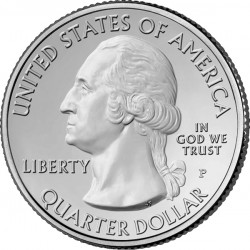
The last coin of 2020 to be part of the US Mint’s America the Beautiful Silver Bullion Coin™ Program will be the 2020 Tallgrass Prairie America the Beautiful Silver Bullion Coin. This coin also numbers fifty-five out of fifty-six that are due to be included as part of the program which debuted in 2010 and runs until 2021.
An image portraying the Tallgrass Prairie National Preserve of Kansas will be seen on the reverse (tails side) of this coin. The entire program was authorized by the America’s Beautiful National Parks Quarter Dollar Coin Act of 2008 which dictates that the reverses of each coin showcase the beauty of the American nation. The program aims to accomplish that goal by featuring a different site of national interest on each coin with one chosen from each state, the District of Columbia and the five territories of the United States (Guam, Puerto Rico, US Virgin Islands, Northern Mariana Islands and American Samoa). National interest sites could include national forests, national parks, national monuments, etc.
The final design for the Tallgrass Prairie strike will probably be unknown until early 2020 when the Mint unveils all five America the Beautiful coins for that year. Early in the previous year, however, the Mint should release design candidates for the coin for review and comment. Two organizations charged with reviewing all US coinage design are the Commission of Fine Arts and the Citizen’s Coinage Advisory Committee. When all relevant comment has been compiled, the Mint Director will forward it along with their recommendation to the Treasury Secretary who will make the final selection.
Another stipulation of the act which created the series states that both these bullion coins and the circulating quarter dollars also created by the act have the same imagery. Since George Washington, the first President of the United States has been on the quarters since 1932, his image will also be found on the obverse of the bullion pieces.
For all bullion coins, the Mint uses a network of authorized purchasers to aid in their distribution to the public. Only this network is allowed to buy the coins directly from the Mint, but it then resells the pieces for a small premium over the spot price of the precious metal contained within them.
All of these bullion pieces are struck to a diameter of three inches from five ounces of .999 fine silver. To plainly show the coins content, its weight and purity will be inscribed on the coins edge.
Four other coins will precede the Tallgrass Prairie strike in 2020 in the America the Beautiful series. These coins will honor the National Park of American Samoa in American Samoa, Weir Farm National Historic Site in Connecticut, Salt River Bay National Historical Park and Ecological Preserve in the U.S. Virgin Islands and Marsh-Billings-Rockefeller National Historical Park in Vermont.
Tallgrass Prairie National Preserve in Kansas
Consisting of only 10,894 acres, the Tallgrass Prairie National Preserve of Kansas recalls the not-so-distant past where tall grasses once covered 140 million acres of North America. But, due to the rush to homestead, farm and ranch in the last two centuries, a majority of those grasses were plowed under.
Today, only an estimated 4% of the original acreage remains of the grass. Wanting to preserve a portion of that, the Tallgrass Prairie Preserve was created in 1996. Different from most national park lands, however, the park service is only allowed to own up to 180 acres of the preserve. The rest is under the ownership of the Nature Conservancy with both organizations cooperating in the management.
Visitors to the preserve will be quick to notice that it is still a developing park. New programs are being initiated almost annually as they are deemed appropriate and non-detrimental to the region. An example of this is a planned bison herd to be re-introduced to the area. Bison once roamed the continent grazing on these tall grasses and their return would mark a significant step towards the return to what once was.
For those unaware of what tallgrasses are, they are varieties of grass once common on the prairie that at times grow well in excess of five feet high. Of course, this does not mean anytime anyone visits the park, they will see grasses as tall as they are. Like all plant life, the grasses have a life cycle. Starting in the spring, the grasses begin their slow ascent with the best heights reached by fall.
Several trails have been created in the preserve allowing visitors access to the prairies.